FSA commissions research to help set sous vide cooking guidelines

While the cooking technique has been practiced in many commercial kitchens for years, its rising popularity and adoption now in some domestic kitchens has brought the need to investigate the potential danger of cooking food at lower temperatures and establish some proper guidelines to protect public health, Dr Sandra Stringer of the Institute of Food Research told BigHospitality.
Stringer, who has produced the initial report for the FSA, said because some foods were being cooked in water baths at temperatures as low as 42°C there was a need to establish when circumstances may be risky.
Studies in existence have looked at the temperatures at which bacteria are killed, usually around 55 to 60°C and above, but similar ones looking at the rate at which bacteria could grow when heating food in the 40 to 60°C range have so far not been officially carried out, making it difficult for cooks, manufacturers, regulators and enforcement officers 'to calculate the lethality of such low temperature heat treatments and judge the risk of foods containing pathogens'.
"We are trying to get the message across that these low temperature systems are blurring the lines about what is 'cooked' and what is 'uncooked'," said Stringer. "There won't be legislation as such, but the FSA want to have advice to say what is safe and what isn't."
Better understanding
Stringer said the chefs she had interviewed for her report had been using equipment properly and didn't seem to be 'pushing the boundaries' with sous vide, but the complexities involved in cooking different ingredients in water baths meant that those who were being more experimental could run into problems.
"Chefs using sous vide in the good restaurants and the caterers using it to speed up preparation for example have been quite knowledgeable and I've found they aren't really pushing the boundaries, but you do have to understand the equipment and use it properly."
Different ingredients could react differently to being cooked at certain temperatures, she said. Steak vacuum packed and cooked in a water bath to make it tender before grilling it would be safe, while the same treatment may not work for fish or liver.
The level of water in the water bath and adding chilled products to a bath with other products already cooking in it would also make difference to the temperature and determine its safety she said.
Stringer said: "When food drops below 40 we know things are going to be growing, but there is this grey area between 50 and 60. If you have cooked meat at 50 you want to know that it isn't going to be a problem and that's something we need to check. People need to know if cooking at this temperature is safe and has killed bacteria or not, once we have properly studied this everyone at least will know where they stand."























